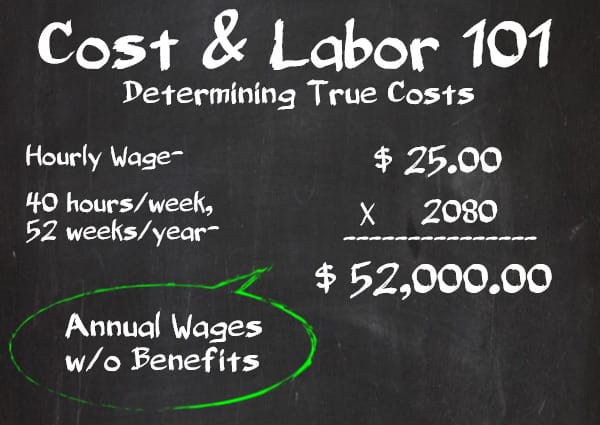We are in the service business, plain and simple. As a contractor in the plumbing, heating or mechanical trade we offer up our expertise and know-how in exchange for a fee. Usually that fee is based off an hourly rate charged to cover all the expenses of being on the job and paying the bills that arrive behind the scenes. When determining a rate for labor, you have to take into account hidden costs like benefits and payroll taxes in addition to wages paid to workers. Even if you don’t have to list labor costs when billing your customers, you still need to know how to allocate costs to labor hours as part of the management of a business.
The labor cost for an employee includes compensation plus any additional expenses linked to that employee. Compensation consists of wages or salary plus employer-paid Social Security, Medicare and unemployment taxes along with workers compensation insurance. Shift differentials, incentive pay and employer contributions to health care and retirement plans are also compensation. You may need to allow for other costs, such as reimbursement for travel expenses, cost of uniforms and operating costs for a company vehicle used by an employee. See the example below for a visual on what we’re getting into.

Actual Labor Hours
A lot of employees will be paid for more hours than they actually work. This isn’t an account for down-time but rather vacation days and sick leave. To calculate the actual wages per hour you first have to multiply an employee’s wage rate by the number of hours they will potentially be paid in a year. For example: An employee who works 40 hours per week [2080 hours per year] or 52 weeks multiplied by 40 hours. If the employee’s wage is set at $25/hr, annual wages equal $52K. If you’re offering up holidays, vacation time and sick time totaling 10 days, which is 160 hours per year you have to subtract 160 hours from the 2,080 to get 1,920 hours actually worked. You then divide the annual wages by the actual labor hours to find the wages per labor hour. See the example below for a visual of how the numbers are crunched.

Labor Burden
To calculate the total labor cost per hour worked, add up all of the non-wage expenses. Suppose you pay $6,000 for payroll taxes and workers compensation insurance, plus another $10,000 for health insurance and contributions to a retirement plan. You also pay $10,000 for fuel cost and truck maintenance. Adding annual wages of $52,000 gives you a total of $78,000. Divide this total by the number of hours actually worked. For a total of 1,920 labor hours, this results in an actual cost per labor hour of $40.63. Thus, although in this example the employee’s wage rate is $25 per hour, you must allocate an additional $15.63 to find the true hourly labor cost. This is only the beginning; I will continue on the subject soon by digging deeper in setting your price and figuring your true cost of business. Please stay tuned!





Join the conversation: